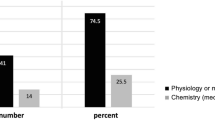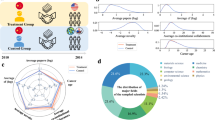Abstract
This paper examines the applicability of Lotka's formulation as a general inverse power (α≠2) and as an inverse square power relationship (α=2) to the distribution of the scientific output in Venezuela. The analysis takes into consideration the sex of the authors and the type of journal, mainstream or national, in which they publish their articles. The data were taken from the last census of scientists and technologists carried out in 1983 by the Venezuelan government. A K-S and a t-test were applied to measure the degree of agreement between the distribution of the observed set of data against the inverse general power relationship (the former test) and the theoretical value of α=2 (the latter). It was found that a general inverse power relationship only describes the productivity pattern of those Venezuelan women scientists who publish in foreign journals. An inverse square power relationship characterizes the distribution pattern for the data set of female authors in all journals and for scientists of both sexes whose contributions appeared in national journals. The values of α suggest that women are less productive than men except in national journals, and Lotka's formulation seems to be useful as an indicator of inequality in male/female scientific productivity.
Similar content being viewed by others
Notes and References
A.J. Lotka, The frequency distribution of scientific productivity,Journal of the Washington Academy of Sciences, 16 (1926) 109.
A.I. Yablonsky, On fundamental regularities of the distribution of scientific productivity,Scientometrics, 2 (1980) 3.
M.L. Pao, An empirical examination of Lotka's law,Journal of the American Society for Information Science, 37 (1986) 26.
D.K. Gupta, Lotka's law and productivity patterns of entomological research in Nigeria for the period, 1900–1973,Scientometrics, 12 (1987) 33.
D.K. Gupta, Scientometric study of biochemical literature of Nigeria, 1970–1984: Application of Lotka's Law and the 80/20-rule,Scientometrics, 15 (1989) 171.
J.R. Cole,Fair Science: Women in the Scientific Community, The Free Press, New York, 1979.
J. Irvine, B. Martin, Women in radio astronomy — Shooting stars?, In:Perspectives on Gender and Science,J. Harding (Ed.), The Falmer Press, London, 1986, p.81.
R.C. Rodgers, C.L. Maranto, Causal models of publishing productivity in psychology,Journal of Applied Psychology, 79 (1989) 636.
Consejo Nacional de Investigaciones Científicas y Tecnológicas (CONICIT),Directorio de Investigadores en Ciencia y Tecnología en Venezuela. 1983, Caracas, 1985.
A.I. Yablonsky,;D.K. Gupta,op.cit., note 4. Lotka's law and productivity patterns of entomological research in Nigeria for the period, 1900–1973,Scientometrics, 12 (1987) 33. Other measurements of inequality of scientific productivity are, for example, the Gini index used byP.D. Allison andJ.A. Stewart (Productivity differences among scientists: Evidence for accumulative advantage,American Sociological Review, 39 (1974) 596) and byS. Kyvik (Productivity differences, fields of learning, and Lotka's law,Scientometrics, 15 (1989) 205). Likewise,P.D.Allison, in his article Inequality and scientific productivity,Social Studies of Science, 10 (1980) 163, proposed also as a measurement of inequality the so-called Modified Coefficient of Variation.
W. Lemoine,La Mujer en la Ciencia en Venezuela. Ph. D. Dissertation. Doctorate in Social Sciences, Faculty of Social and Economic Sciences, Universidad Central de Venezuela, Caracas, 1985.
According toPrice, the elite of high producers do not conform to the inverse power relationship of productivity, and they constitute the square root of any population of size Y; for this reason they are not included in the present analysis:D.J. de Solla Price,Little Science — Big Science, Columbia University Press, New York and London, 1971.
M.L. Pao, Lotka's law: a testing procedure,Information Processing and Management, 21 (1985) 305.
It can be noticed the existence of a large number of individuals (34%) who have never published, however they were taken as “scientists” by the Venezuelan census; of course they were excluded of the present analysis. Other censuses carried out in that country in the 60's and 70's reported similar figures (D. Arnao de Uzcategui, et.al.Diagnóstico de la Actividad de Investigación y Desarrollo Experimental que se Realiza en el País, Consejo Nacional de Investigaciones Científicas y Tecnológicas CONICIT, Caracas, 1973;O. Gasparini,La Investigación en Venezuela, Condiciones de su Desarrollo, Instituto Venezolano de Investigaciones Científicas IVIC, Caracas, 1969). Silent Stanleys and Susans has also been detected in scientific communities of developed countries such as USA (Cole,op.cit., note 6). In a work in progress on the scientific productivity in India, we find a relatively high percentage of mute Shri, Mrs and Doctors considered by their scientific institutions as “researchers”. These facts would indicate that the existence of non-publishers dress up as a scientists and considered by his/her institution as member of the Academia is an universal trait.
These figures correspond to 96.42% of men researchers and 95.20% of female researchers. The remainder excluded from the analysis resemble the\(\sqrt {YX} \).
The percentage of population not included in the least square analysis is 6.6% of males and 2.8% of females. The square root of the former population comprises about 4% of scientists, the square root of the latter 7%.
The first 17 points conform 95.5% of the male scientists. The square root of this population is 3.6%. The first 13 points comprises 98.5% of the female researchers. The square root of the total population of women publishing in national journals is 5.3%.
Price,.
W. Glänzel, A. Schubert, Price distribution. An exact formulation of Price's “square root law”,Scientometrics, 7 (1985) 211.
S. Kyvik,.
M.L. Pao,.
P.D. Allison,.
Author information
Authors and Affiliations
Rights and permissions
About this article
Cite this article
Lemoine, W. Productivity patterns of men and women scientists in Venezuela. Scientometrics 24, 281–295 (1992). https://doi.org/10.1007/BF02017912
Received:
Issue Date:
DOI: https://doi.org/10.1007/BF02017912




